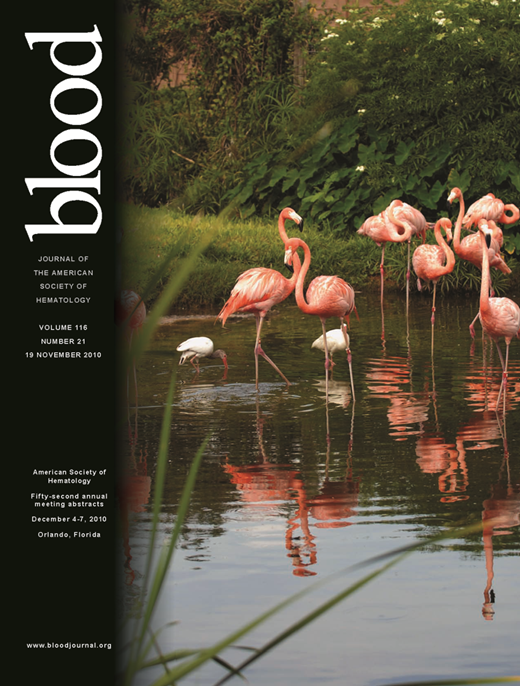Abstract
Abstract 3372
Enhanced expression of the Fanconi Anemia (FA)/BRCA DNA repair pathway correlates with melphalan-resistance in multiple myeloma (MM) cell lines. Continued investigation demonstrated a bortezomib sensitive RelB/p50-mediated regulation of the FA/BRCA pathway contributed to the observed melphalan resistance.(Yarde et al 2009) The FA/BRCA pathway represents a co-dependent DNA damage response pathway involving thirteen loss of function complementation groups cloned from FA patients. The key functional event of this pathway is the interdependent mono-ubiquitination (Ub) of FANCD2 and FANCI (ID complex) by the E3 Ub-ligase activity of the FA core complex a multimer consisting of 8 FA (FANCA, B, C, E, F, G, L and M) and three non-FA proteins (FAAP100, FAAP24 and HES1). Formation of the core complex and mono-Ub of the ID complex appears to revolve around the flexible adapter protein FANCF. Nuclear localization of the core complex components requires binding of FANCA/G and FANCC/E subcomplexes to the C- terminal domain (CTD) and NTD domains of FANCF, respectively. This complex associates with FANCM:FAAP24 at sites of interstand crosslinks (ICL) via the FANCM-binding domain of FANCF, culminating in ID complex mono-Ub, recruitment of BRCA1, BRCA2/FANCD1, FANCJ and FANCN, and homologous recombination (HR) repair. Reduced function of this pathway has been associated with increased genomic instability, cancer susceptibility, and increased sensitivity to DNA cross-linking agents in FA. However, as predicted by the role of the FA/BRCA pathway in DNA repair, enhanced expression of the FA/BRCA pathway has been shown to play an important role in resistance to agents requiring HR for ICL repair. We next examined expression of this pathway in models of resistance to DNA damaging agents not predicted to utilize FA/BRCA activity. We screened 8226/Dox40 doxorubicin resistant and 8226/MR20 mitoxantrone resistant MM cell lines for expression of the 12 FA/BRCA pathway members with quantitative PCR (qPCR) using customized micro-fluidic cards. Interestingly, in these models of topoisomerase (topo) II inhibitor resistance qPCR demonstrated a 2.6 (p<0.05) and 1.7 (p<0.05) fold over expression of FANCF mRNA relative to drug sensitive RPMI8226 cells. Importantly, mRNA expression of other the eleven FA/BRCA pathway constituents was not increased relative to sensitive cells. To further characterize the relationship between FANCF and doxorubicin resistance, we examined mRNA and protein expression of FANCF in RMPI8226, 8226/Dox6 and 8226/Dox40 MM cell lines (representing progressive levels of doxorubicin resistance). FANCF qPCR demonstrated a 2 and 4.7 fold increased in mRNA expression in the 8226/Dox6 and 8226/Dox40 cell lines, respectively (p= 0.103 and p= 0.034) suggesting that increasing expression of FANCF correlated with increasing dox resistance. A similar doxorubicin resistance- dependent increase in FANCF protein was demonstrated by Western blot analysis of these cell lines. Consistent with mRNA results, FANCD2 or FANCG protein levels remained unchanged in the doxorubicin resistant versus sensitive cell lines These observations suggest that FANCF may contribute to topoII inhibitor-mediated DNA double strand break repair, a process that primarily thought to involve non-homologous end joining (NHEJ) independent of the FA/BRCA pathway. To determine if FANCF expression alone could facilitate doxorubicin resistance, pQCXIP-control or pQCXIP-FANCF constructs were expressed in RPMI8226 sensitive MM cells. MTT assays demonstrated a greater than 2 fold resistance to doxorubicin in FANCF over expressing cells at 48 and 96 hours (IC50: 1.33 ×10−6 and 5.3×10−9M) as compared to control cells (3.26×10−6 and 1.13×10−8M). Taken together, these results indicate that the flexible adaptor protein FANCF may participate in doxorubicin resistance independently of other FA/BRCA members. However, future studies will be needed to elucidate the nature of FANCF in doxorubicin resistance.
No relevant conflicts of interest to declare.
Author notes
Asterisk with author names denotes non-ASH members.

